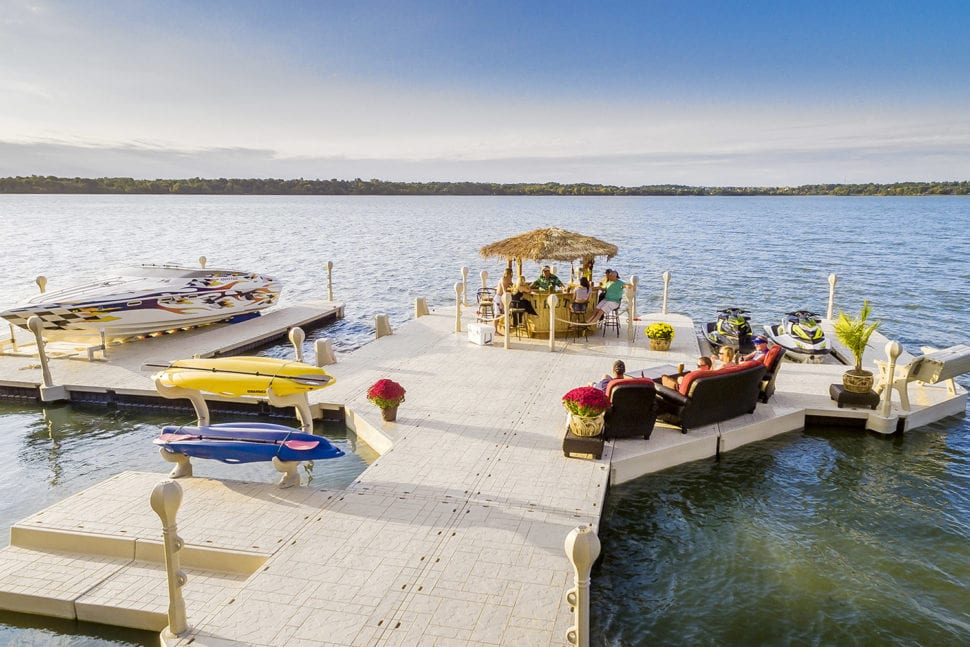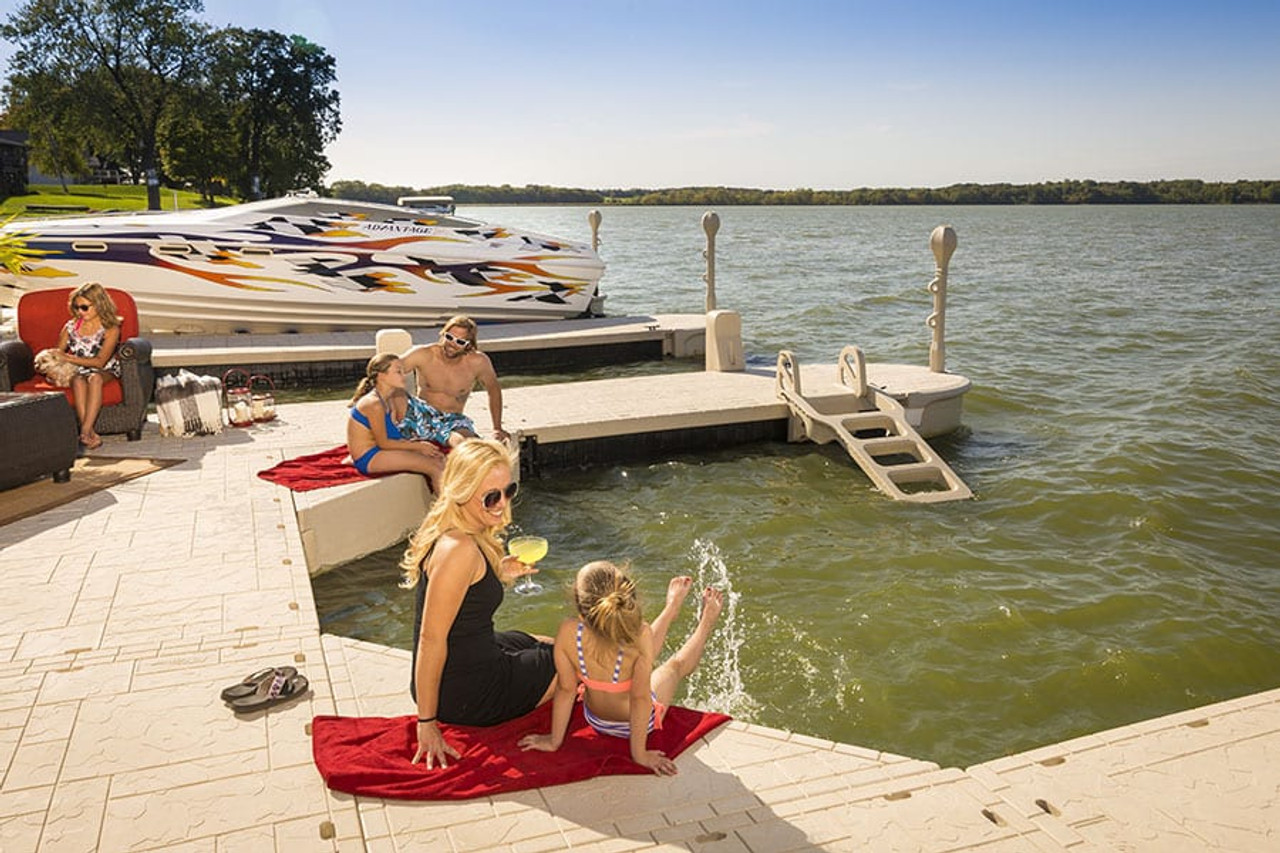Locate the Perfect Floating Dock Builder to Bring Your Waterside Vision to Life
Locate the Perfect Floating Dock Builder to Bring Your Waterside Vision to Life
Blog Article
Develop the Perfect Docking Option With Floating Docks
Floating docks existing a versatile service for a variety of maritime needs, adapting effortlessly to changing water degrees and varied vessel kinds. As we check out the crucial aspects that contribute to the effectiveness of floating docks, numerous crucial aspects pertaining to security and upkeep will arise, raising inquiries regarding exactly how to enhance your docking experience.

Advantages of Floating Docks
Floating docks deal countless advantages that make them a perfect selection for various maritime applications. One of the key advantages is their versatility to transforming water levels. Unlike dealt with docks, floating docks fluctuate with the trend, making sure consistent ease of access for vessels. This feature is particularly vital in areas prone to considerable tidal changes or seasonal water level modifications.
Additionally, floating docks are normally simpler and quicker to set up compared to traditional set structures. Their modular design enables straightforward assembly and disassembly, facilitating upkeep and relocation when required. This adaptability is specifically valuable for short-lived applications or in atmospheres where conditions may transform.
Floating docks also tend to be extra ecologically friendly, as they lessen interruption to the seabed and bordering aquatic environments. Their resilient nature reduces the threat of damages to marine life, advertising a healthier setting. These docks can be personalized to suit different vessel dimensions, making certain that they satisfy particular operational needs.
Eventually, the mix of adaptability, simplicity of installation, and environmental factors to consider makes floating docks a very effective remedy for a variety of maritime needs.
Picking the Right Materials
Picking the appropriate materials for floating docks is critical to make sure stability, durability, and longevity. The option of materials directly influences the dock's performance in various environmental conditions, including exposure to water, sunshine, and potential wear from marine web traffic.
Usual materials made use of for floating docks include aluminum, wood, and high-density polyethylene (HDPE) Light weight aluminum is light-weight, corrosion-resistant, and calls for marginal maintenance, making it an outstanding selection for longevity. Its preliminary expense can be greater compared to various other products.
Timber, while cosmetically enticing and offering a standard appearance, can be susceptible to rot and insect damage if not properly dealt with. Using pressure-treated timber or naturally resilient species like cedar or redwood can minimize these problems.
HDPE is a popular selection as a result of its resistance to UV rays and chemicals, together with being environmentally friendly. floating dock services. It is readily available and lightweight in different colors, permitting personalization
Inevitably, the appropriate material choice will rely on particular needs, consisting of spending plan, desired aesthetic appeals, and environmental factors to consider. Cautious examination of these variables will certainly cause a successful and resilient floating dock service.
Style Factors To Consider for Security
When creating floating docks, making sure security is an essential aspect that can substantially affect their performance and security. Stability in floating dock design is influenced by numerous elements, consisting of buoyancy, weight circulation, and the plan of elements.
Weight circulation is important; uniformly distributing loads across the dock stops tilting and improves stability. This can be attained with tactical placement of docking equipment, such as cleats and fenders, as well as proper spacing of drifts. In addition, the measurements of the dock must be attentively intended. Bigger styles can provide enhanced stability, particularly in harsh water conditions, while longer docks may require extra assistances to prevent drooping.
Another key factor to consider is the ecological influence, consisting of wave action and wind. Including functions such as sidewalls or skirting can aid minimize the impacts of ecological pressures, keeping stability in unfavorable problems. Inevitably, a mix of thoughtful layout, product option, and understanding of discover this info here environmental factors will certainly yield a floating dock that fulfills both stability and safety requirements.
Installation Tips and Strategies

Next, safeguard the necessary licenses and abide by local policies, which may dictate installation techniques and environmental factors to consider. Engage a qualified specialist experienced in floating dock setups if called for. Use top notch products made for aquatic atmospheres to enhance resilience and long life.
When placing the dock, straighten it parallel to the coastline to help with very easy accessibility. Make sure that the anchoring system is durable, using concrete blocks or helical anchors to maintain the dock versus wind and wave activity. It's critical to make up seasonal water level fluctuations, consisting of prospective ice motion in colder environments.
During the setup, verify the dock's floatation and stability prior to completing the anchoring. On a regular basis inspect the installment for any indicators of wear or damage. By adhering to these tips and strategies, you can achieve a secure, practical, and aesthetically pleasing floating dock setup that meets your demands.
Maintenance and Treatment Standards
Preserving and caring for floating docks is important to prolonging their life expectancy and guaranteeing risk-free usage. Normal assessments need to be published here performed to identify any indications of wear, damage, or aquatic development. Try to find fractures, loose fittings, or stained locations on the dock's surface, as these concerns can endanger architectural integrity.
Cleaning is important. Use a pressure washer to get rid of algae, barnacles, and debris, which can gather gradually. For persistent growth, consider ecologically friendly cleaner that won't damage aquatic life.
In addition, inspect the mooring lines and supports regularly to guarantee they are totally free and safe from rust. Replace any type of torn or harmed lines without delay to maintain stability.
Throughout severe weather, such as storms or freezing problems, take preventive steps. Secure the dock with extra mooring lines and, if practical, get rid of any kind of detachable elements to avoid damage.
Conclusion
To conclude, the application of floating docks provides a reliable and functional docking option ideal for different maritime applications. Their flexibility to changing water degrees, integrated with a modular style, permits easy modification and moving. Picking ideal products boosts both sturdiness and aesthetic appeal, while careful factor to consider of security ensures safety and security and longevity. With correct installation and normal upkeep, floating docks can provide trustworthy and reliable docking experiences for a wide variety of vessels.
As we explore the crucial elements that add to the efficiency of floating docks, a number of essential aspects concerning stability and upkeep will certainly arise, increasing inquiries about exactly how to optimize your docking experience. Unlike fixed docks, floating docks surge and fall with the tide, making sure regular accessibility for vessels.When creating floating docks, making sure security is a fundamental aspect that can dramatically influence their capability and safety and straight from the source security. Stability in floating dock design is influenced by various elements, consisting of buoyancy, weight distribution, and the plan of elements. Ultimately, a mix of thoughtful style, product option, and understanding of ecological variables will yield a drifting dock that fulfills both security and safety and security requirements.
Report this page